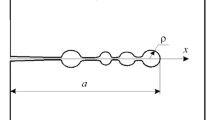We formulate a computational model for the prediction of compressive strength of a composite based on the cement matrix and microfibers of different nature. We deduce an analytic dependence of the strength of this composite on the mechanical properties of its phases, their bulk fractions, and the parameters characterizing the degree of porosity of the matrix. The determination of the influence of the degree of damage to the material caused by microcracking on the interfaces in compression represents an important element of the model. In some cases, the microcracks located on the interfaces between the filler and the matrix may compensate the effect of strengthening of the matrix by its reinforcement with fibers and even decrease the compressive strength of the composite. The results of our compression tests of prismatic specimens made of a composite based on cement stone and basalt microfibers used as filler elements are in good agreement with the accumulated numerical data.







Similar content being viewed by others
References
A. E. Naaman, “Tensile strain hardening FRC composites: historical evolution since the 1960s,” in: C. U. Grosse (editor), Advances in Constructional Materials, Springer, Berlin (2007), pp. 181–202.
N. Banthia, M. Azzabi, and M. Pigeon, “Restrained shrinkage cracking in fiber reinforced cementitious composites,” Mater. Struct., 26, No. 161, 405–413 (1993).
K. Marar, Ö. Eren, and T. Çelik, “Relationship between impact energy and compression toughness energy of high strength fiber reinforced concrete,” Mater. Lett., 47, No. 4–5, 297–304 (2001).
M. C. Nataraja, T. S. Nagaraj, and S. B. Basavaraja, “Reproportioning of steel fiber reinforced concrete mixes and their impact resistance,” Cement Concrete Res., 35, No. 12, 2350–2359 (2005).
Z. Xu, H. Hao, and H. N. Li, “Experimental study of dynamic compressive properties of fiber reinforced concrete material with different fibers,” Mater. Design, 33, No. 1, 42–55 (2012).
A. Kronlof, L. Markku, and S. Pekka, “Experimental study on the basic phenomena of shrinkage and cracking of fresh mortar,” Cement Concrete Res., 25, No. 8, 1747–1754 (1995).
A. M. Brandt, Cement-Based Composites: Materials, Mechanical Properties, and Performance, 2nd edn., CRC Press (2009).
M. Jefferey and H. B. Lemm, Fiber-Reinforced Concrete: Principles, Properties, Developments, and Applications, Building Materials Science (1990).
B. Maidl, Steel Fibre Reinforced Concrete, Ernst & Sohn, Berlin (1995).
F. N. Rabinovich, Composites Based on Fiber-Reinforced Concretes. Problems of Theory and Designing, Technologies, Structures [in Russian], Assots. Stroit. Vyssh. Uchebn. Zaved., Moscow (2004).
D. J. Hannant, Fibre-Reinforced Concrete in Advanced Concrete Technology (Processes), Elsevier, Oxford (2002).
K. Ramujel, “Strength properties of polypropylene fiber reinforced concrete,” Int. J. Innov. Res. Sci. Eng. Technol., 2, No. 8, 3409–3413 (2013).
V. P. Sylovanyuk, R. Ya. Yukhym, A. E. Lisnichuk, and N. A. Ivantyshyn, “Computational model of the tensile strength of fiberreinforced concrete,” Fiz.-Khim. Mekh. Mater., 51, No. 3, 39–45 (2015); English translation: Mater. Sci., 51, No. 3, 340–347 (2015).
V. P. Sylovanyuk, R. Ya. Yukhym, N. A. Ivantyshyn, and A. E. Lisnichuk, “Prediction of the crack resistance of cement stone and fibrous concrete,” Fiz.-Khim. Mekh. Mater., 51, No. 4, 120–125 (2015); English translation: Mater. Sci., 51, No. 4, 570–574 (2015).
Yu. V. Zaitsev, Modeling of the Strains and Strength of Concrete by the Methods of Fracture Mechanics [in Russian], Stroiizdat, Moscow (1982).
N. I. Muskhelishvili, Some Basic Problems of the Mathematical Theory of Elasticity [in Russian], Nauka, Moscow (1966).
A. G. Evans and Y. Fu, “Some effects of microcracks on the mechanical properties of brittle solids. II. Microcrack toughening,” Acta Metal., 33, No. 8, 1525–1531 (1985).
Author information
Authors and Affiliations
Corresponding author
Additional information
Translated from Fizyko-Khimichna Mekhanika Materialiv, Vol. 52, No. 3, pp. 35–41, May–June, 2016.
Rights and permissions
About this article
Cite this article
Sylovanyuk, V.P., Lisnichuk, A.E., Yukhym, R.Y. et al. Prediction of the Strength of Fibrous Concrete in Compression. Mater Sci 52, 330–338 (2016). https://doi.org/10.1007/s11003-016-9961-x
Received:
Published:
Issue Date:
DOI: https://doi.org/10.1007/s11003-016-9961-x




